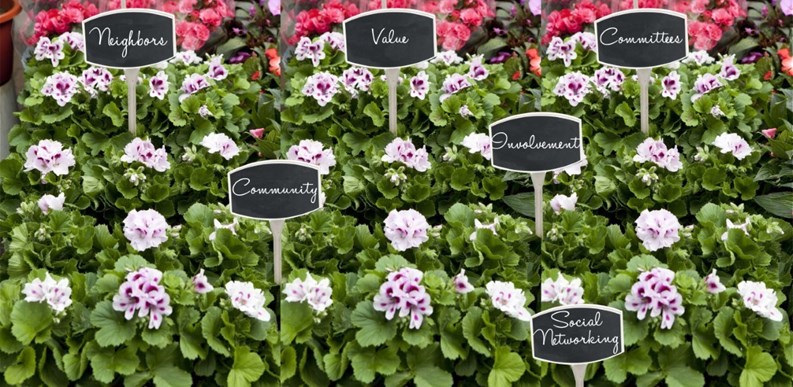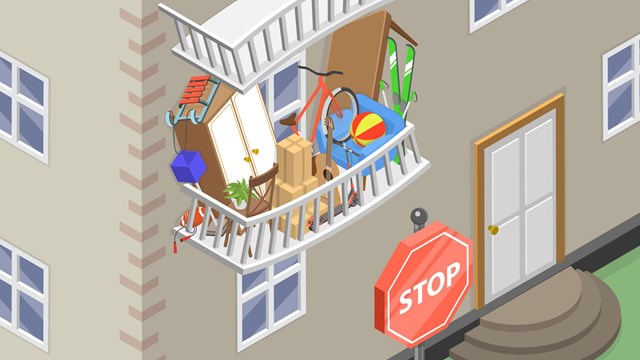The word community, like many words in the English language, has more than one interpretation. A community can be identified as a geographical location—a physical infrastructure of streets, parks and buildings, defined by tangible brick and mortar structures. But a sense of community is often emotional, intangible and much more difficult to define; it is what makes an address a home, not just a location.
Cultivating a sense of community can present a challenge for residents, property managers and homeowners associations. In a sprawling, heavily-populated, urban environment like New York City it is still possible to feel a disconnect from other residents, even those living in the same building, and sharing the same amenities. A sense of community doesn’t automatically come along with the lease. There has to be a vested interest in cultivating and creating that hard to define but valuable support system. Chances are you will not find “foster a sense of community” in any one person’s job description. Creating that special feeling of connectivity tends to be a group effort, and requires a team approach.
Marni Berk is a general manager and team leader for FirstService Residential working on-site at Lincoln Towers. She believes a sense of community is a top-down responsibility. “It is up to the board and the managing agent, working together, to instill the feeling of community,” she states. Berk is aware that most board members typically work in other fields, and that is why a partnership of effort is important. “The board supplies the focus and the agent is available for the follow up and follow-through.” Berk is also in favor of using a committee approach and involving interested residents in building decisions whenever possible. “The board will make the final decision, but committees allow others to have a voice, she explains. Committees can lighten the workload, and having shareholders involved also helps build a sense of community, and community pride.”
In Berk’s experience many residents have valuable skills to contribute, but she cautions, “Even with a committee, you cannot please everyone.” Still she believes the involvement tends to make people feel good about where they live, which in turn makes residents more likely to pick up after their pets, or check on a neighbor, and take better care of the property. “Involvement helps build a different environment,” she says.
Berk has other tools in her toolbox besides involving residents in committees. Communication systems, events, and parties are other ways she helps to foster a community feeling at Lincoln Towers.
Many managers are making use of online communications technology to strengthen communication with their client communities. Berk uses mybuilding.org, an electronic communications system that provides each property with a custom website with all its documents, updates and information, as well as info about the neighborhood—all continuously updated by the property manager and the site's support team.
Online community sites like these allow residents to log in with a private password to receive updates and to communicate with building management, or submit maintenance requests.
“The Internet has increased communication between boards and residents and unit owners,” says Berk. “I just love it.”
Berk uses this effective tool to keep residents informed on all levels, both social and maintenance. She tries to be proactive, anticipating the questions surrounding a given post, and having the answers readily available. Answers to questions like “How long will the air conditioning be serviced?” or “Where is the clothing donation bin now located?” can reassure residents and shareholders, and strengthen a sense of community by effectively saying, “we care about you.”
Berk recently sent that message loud and clear when she arranged for a fire safety event for the buildings she manages. She also promotes Project Open, as a resource for senior residents for outings and interaction. She also is aware of the who, what and where of resident-arranged and driven activities like reading groups, card and movie nights and mahjong games. “Not every building will have space to promote and share these activities, but if a gym or community room is available, residents and management can work out some regularly scheduled events.”
One of the buildings Berk manages has renamed a multi-purpose room, the “play-munity room.” This adaptable space can be divided into two areas to effectively provide for events and socials.
Anyone looking to grow a sense of community can benefit from looking at the sensitive social interaction Berk and her team have fostered at Lincoln Towers. Major holidays are recognized and celebrated in every building, all cultures are represented and the children are encouraged to make decorations and help decorate the common areas. Additionally, Berk and FirstService Residential feel board members and property managers should regularly attend social gatherings and holiday parties. “Socials provide an opportunity for interaction with residents and neighbors in an informal setting, Berk explains. There is an opportunity we don’t normally see during regular business hours.”
Jay Cohen is vice president and director of operations for A. Michael Tyler Realty Corporation. Over the last twenty five years he has learned what is necessary to build a sense of community, and what can be most detrimental to those efforts. A. Michael Tyler manages property in Manhattan and Queens.
Like Berk, Cohen favors a web-based communications program to keep residents informed and engaged in the regular day to day happenings within the communities he manages. He uses a paperless platform called BuildingLink.com to save time and stress for management, staff and residents. Among other things, the service allows for a bulletin board to list items residents want to buy or sell. Once Cohen approves the content for posting, anything from unused furniture to tickets for a ballgame may appear in this online bazaar. Information is readily available on a 40-inch monitor mounted near the mailboxes for convenience. Residents can tell at a glance if they have packages or dry-cleaning to pick up, or if there is something else of interest happening in the building.
Cohen notes social media is also playing a part in building a sense of community for some buildings, and many properties now have Facebook pages where residents can post photos, information, and happenings. Everything from yoga classes to crafts, and holiday parties can enhance a sense of community and make a property more appealing for residents and management. Cohen also likes to see committees involved in selecting activities and classes for community involvement. One board member will typically be in charge of a committee in order to provide seamless communication between the committee and the board.
When there is a defined sense of community and ownership, Cohen says he finds that residents just naturally take more interest in the care and maintenance of the property. If there is a loss of the sense of community, it can translate to a lack of morale, which in turn affects the real and perceived value of a property. Value is definitely enhanced by a sense of community, and almost always results in an improved bottom line for owners.
Cohen believes the biggest determent to community building has historically been economic conditions. “In times of economic hardship, subletting becomes more prevalent, and it can destroy a sense of community. If a condo—or more infrequently a co-op—becomes an investment vehicle for too many owners, the quality of life within a community may suffer.”
But what if all the units are sublet, or rented? Is it possible to have a sense of community with a total rental property? Alan Pearlstein, senior property manager for FirstService Residential believes it is. He is an owner’s representative for the Icon, a 120-unit building housed in the revamped Graves Hotel in historic Hell’s Kitchen. Pearlstein works closely with Anna Zarro, director of marketing and leasing for Town Residential, the developer and owner of The Icon.
Zarro has a decade of experience in property management after an earlier career in hospitality, and is keenly aware of the need for a sense of comfort and community in order to keep units occupied and appreciated. “New York City is a destination city, but everyone is not in the market to buy immediately, she explains. The Icon offers flexibility and a midtown address, with a level of consistency and maintenance that is not possible with sub-letting.” Like Cohen, Zarro favors BuildingLink to keep residents informed up-to-the-minute. Along with Berk and Cohen, she also uses newsletters for events with more shelf life.
The Icon spaces are small (the building is only 27 feet wide) and rents are steep, but the benefits and the sense of community keep this property at or near capacity. Zarro makes full use of the roof deck when planning events.
“A real benefit for the residents is the social-economic networking opportunities among the residents, she states. Business is carried out on the roof, in the spa and the gym every day.” She describes an interactive community of professionals at The Icon, enjoying the sense of community and sharing the photos and events via social media. This works well for Zarro, Pearlstein, and professionals like them because of the team approach they have recognized and implanted to create perhaps the best amenity possible for any property—a sense of community.
Anne Childers is a freelance writer and a frequent contributor to The Cooperator.







Leave a Comment